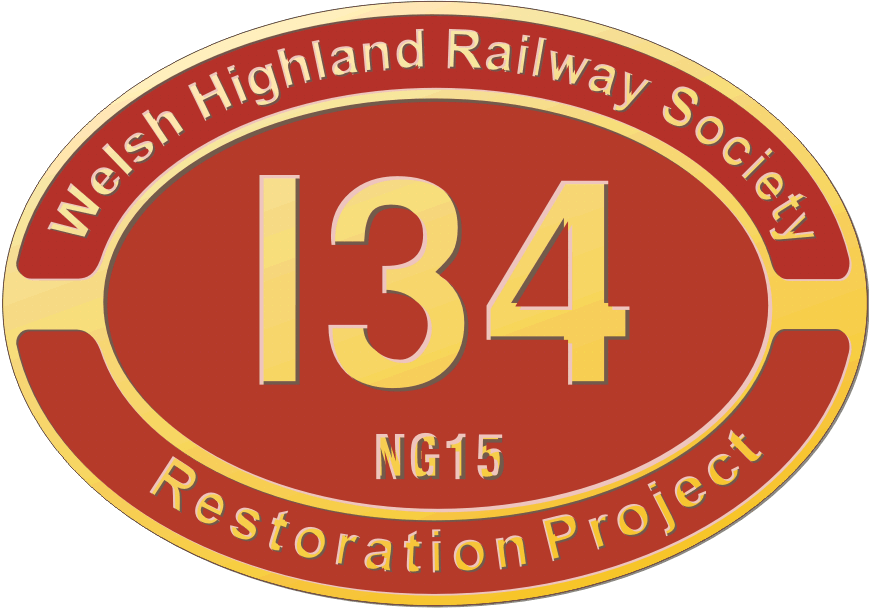
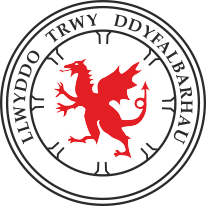 

|
 |
|
| Back to archived working party reports |
December 2014 Working Party
There were a good number of us on both days this weekend and as our engineer directing us felt he had more than enough effort for the planned work we also carried out some work on the Garratt loco, K1.
In summary on this, K1 is now being stripped down for its 10 year boiler examination so the loco needs a number of its major components removing to enable the boiler to be inspected. On the Saturday a few of the NG15 team therefore removed K1's ashpan and then removed the brick arch from inside the firebox. On the Sunday they then lifted the front tank from off the front power unit.
Back on the NG15 however, one area of work continuing from last month was progressing the overhaul of the Chinese lubricator to ensure its correct function. It's interesting to note that this is almost an exact (Chinese!) copy of a US Nathan DV type lubricator. These are one of the most reliable types to be found so hopefully it'll do good service for us. Compare the photo of ours in the pictures below, and in the November report further down, with an original Nathan DV here.
The Chinese mechanical lubricator being re-assembled (left) and the driver's side pipework run, still looking a bit messy at this stage (right).
The seeming never ending grease pipework was another area of activity this month. With the left hand, fireman's side complete we're now concentrating of the driver's side as well as progressing a new pipe run to lubricate the two rear pony truck side compensation arms' ball joints on the frames. The driver's side run consisted of the annealing of a number of pipes and their final bending into shape followed by the silver soldering on of the end nipples. There's still some of these to be finished off followed by their final fitting and coaxing into the correct position in the pipework run.
For the new pony truck ball joints run, a suitable path for them to take was marked out and some suitable locations for attachment clips marked as well. This was followed by the manufacture of suitable clips and a start made on drilling and tapping attachment bolt holes for them.
And that just leaves a mention of the continuing work on the vacuum pipe run. Much of this work though is being done by Team Wylfa during their weekly evening working parties.
October and November 2014 Working Parties Summary
This is a summary of the October and November working parties as the writer here was unavailable for both of these and has been unable to make timely updates to the website. Also much of the work concerned was really just a continuation of work on the existing 'fronts'.
The main focus of these weekends has been that of finishing off the copper grease pipework on the left hand, fireman's side of the loco. This consisted tweaking the pipework into its final position and then silver soldering on the end nipples that will attach into the terminating fittings at the various fixtures that are being lubricated by grease. Work also moved onto the pipework on the right hand, drivers side, although there is much more still to be done on this side.
As well as this, the Chinese mechanical lubricator to be used for the axleboxes was being worked on. It had been inspected and cleaned earlier, however, some further detailed investigation work is needed to check it correct assembly.
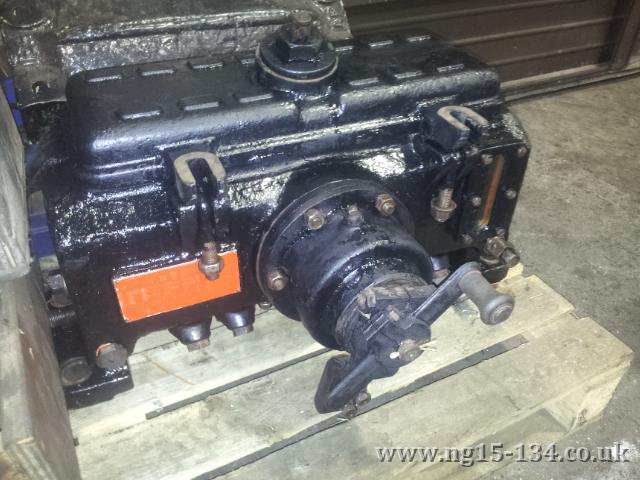 |
The Chinese mechanical lubricator.
On top of this the vacuum pipe run through the loco frames continued.
September 2014 Working Party
The weekend of this September working party was coincident with the Welsh Highland Railway's Superpower Gala and as such it was intended to highlight the status of the restoration. It was also hoped that we would have a 'showcase' re-wheeling the loco. However, due to a number of factors intervening such as some dimensions on the axle boxes not adding up and thus preventing their machining in time, together with the railway's decision to hold Superpower at the Porthmadog end of the line, all we really did was entertained any visitors that arrived and did a few minor jobs.
On the jobs side some of the vacuum pipes were painted. The two tender bogies that were stacked on top of each other to save space were separated so as some investigation could be done into a misalignment issue with one pair of axle-box guides on one axle on one of the bogies.
The two tender bogies.
Another job was the conversion to grease of the two pairs of ball joints on the two side thrust compensation arms that are located on the loco frames. This involved drilling out the oil hole and tapping it to take a standard pipe fitting. This first involved the removal of the rear pair of ball sockets from off the frames.
One of the front sockets was done some time ago (see the March 2014 working party Gallery page - top left image) to order test the conversion method. But.... as with all these things, that one by fluke was easy. Coming to do the other three and we immediately found that the castings that required drilling were hardened in the area of the oil-hole. All we succeeded in doing was to blunt the drills. After several re-sharpens the Plan B therefore was to make a short steel stand-off that was drilled and tapped out of a short lenght of 1" round bar to take the brass pipe fitting. This will then be welded onto the ball socket casting and the weekend finished with these ready to be welded into position next time.
So what of the Superpower event? We weren't expecting that many visitors, however we did set up our 'merchandise' stall next to the loco in the hope of making an odd sale or three. We had a large group visit us on Saturday morning as part of a Ffestiniog Travel tour and this was followed by a few others during the course of the day. Sunday was much the same but without the initial tour group. We did however have quite a few who came over on the service train and returned on the return service.
In order to help sales some of the group went down to Caernarfon on the Saturday and mingled amongst interested passengers. In the end however both this and sales from the stand resulted in some £400 into the funds. All very welcome and and added bonus to what was otherwise a quite weekend.
July 2014 Working Party
This was the intended working party for July, however much of the team's time was spent helping out with the railway's NGG16 Garratt locos for the service trains. It therefore meant that only a limited amount of work was possible on the NG15.
Unfortunately the grate had collapsed on NGG16 №143 so the team were asked to repair it ready for service. №s 87 and 138 were providing the motive power for the two service trains at the weekend, however on the Sunday it was reported that No138's had problems with its brick arch so there was a more urgent need to get №143's grate repaired.
The weekend however, did see some work progressed on our №134. This consisted mainly of more painting of the tender wheels and a general tidy up around the main loco frames.
Well, the tidy-up and associated work was rather extensive really as it is anticipated that we'll re-wheel the loco at the next working party that will be in September and will coincide with the Railway's annual SuperPower Gala. To this end the railway's full time staff have been contracted to, and are progressing work on the main driving wheels with all the journals now turned and completed.
Interim Report 14th July 2014
Since the last working party Team Wylfa have been quietly working away as time allows from the summer task of caring for the working railway's carriage fleet. The main area they've concentrated on is tidying up the running plate level of the loco frames and the attachment of the remaining running plates themselves. This is so as the attachment positions of the last few remaining lubrication pipework clips can be determined.
They've also been continuing with the vacuum pipe. This can be seen in the photo below where the pipe attached is in the centre of the framed with the next jointing flange in view. the next piece is to its left ready bent, however, it still needs some final bends adding before fitting. Also there are a number of brackets to be fitted that will hold the pipe in place.
The tidied running plate area
Up until recently, the vacuum ejector was to have been a Gresham & Craven smokebox mounted unit but a Davies & Metcalf cab-mounted unit has become available. This will only require the one pipe running from bufferbeam to bufferbeam instead of having to run a second line from smokebox to cab. All that'll be need therefore, will be a single T section running off the current pipe into the cab.
2nd June 2014 Working Party
A more quiet weekend following the euphoria of the last working party - it must be lack of BBQ that did it.
A number of jobs were progressed. Regarding the tender bogies that were the subject of intensive attention last weekend, on the Saturday we cleaned and painted the set of wheels from under one bogie. These were returned to their rightful place on the Sunday whilst the set from under the other bogie were duly removed and needle gunned clean ready for painting next time.
One job completed was that of squaring the horns. All faces are now flat and square. These now await the axle boxes and these are being worked on at Boston Lodge. The picture below shows that wastage is being repaired by building up with weld. These will then have their white metal bearing surfaces cast then the whole assembly machined to match the horn guides in the frames.
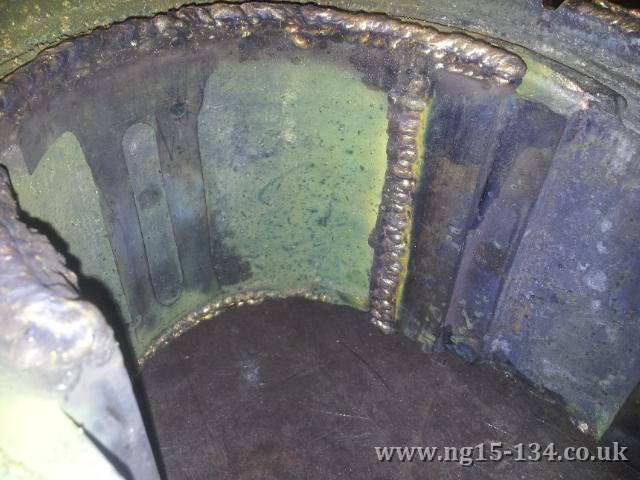 |
The axle boxes receiving attention at Boston Lodge
The cleaning up and refurbishment of the Chinese mechanical lubricator from off a C2 loco was also another job attended too. The lubricator is pictured below in the earlier June working part report. It will be used for theaxle box lubrication.
And then there's the Vacuum pipe run where a little more of it was completed. Alongside this the area where the running plate will go was tidied up ready for its replacement.
June 2014 Working Party
Well what a fine weekend this was. Not specifically as regards the weather, as it was alarmingly wet on the Saturday morning that worried us as it was due to be our BBQ that evening, but more from the progress made and those attending.
With six of us there on the Saturday we continued the work started at the last working party of manufacturing cotters for the brake rigging. There are a lot needed - sixty something in total at the last count! Four had been started and completed last time and with more of us to work on them, especially with 11 of us there on Sunday, we set to and made more in various sized batches, usually in fours, or eights. These numbers matching the 'corner' symmetry of the bogies requirements. There were also three different sizes being made. It ended up with one person dedicating to cutting out the blanks, another was drilling a stress relief hole in the corner where the 'L' would be cut, another cutting out the 'L' shape and rounding one of its end faces. Finally various people were then carefully fitting these so as to be a nice snug fit in their location before finally drilling the hole for the securing split pin.
One set of manufactured brake rigging cotters (left) and when fitted (right) also showing its 'pop-mark' numbering.
This was a real team effort that by the end of Sunday had caught 'the Boss' Andie out with the speed of progress! By the end of Sunday we'd made (if memory serves me correctly) thirty six in total, of which four were actually for the Loco's brake rigging.
On the Sunday the fitting of the cotters was also allowing the full assembly of the tender bogies brake rigging. For this the shed's A-frame was made use of to raise each end of each bogie in turn to enable fitting of the various components.
One of the team continued his work on the assembly of the angled edging to the running plate and cab bottom. This is taking quite a bit of time as it's made out of several sections all of which need to be perfectly squared as it's critical to the alignment of the cab, but also as care is being taken with the aesthetics and 'line' of this bottom edge by 'flaring' all the right angle bends in it.
Our intrepid leader Andie was continuing his task of grinding the horn guide slippers square. Again it's a long process with him having to go very slowly checking alignment as he goes, not helped by the continual consultations he has to attend to. He had made considerable progress during the previous couple of weeks whist visiting for a stint of driving and 134 restoration work such that by the end of the weekend there were only two faces left to grind.
Grinding the penultimate horn guide (left) and the newly acquired mechanical lubricator from off a Chinese C2 Loco (right).
In the week before the working party Andie had taken delivery of our second mechanical lubricator for axlebox lubrication. This was acquired from China by the C2 Project group who are restoring one of those locos for operation on the Ffestiniog Railway. They had bought four for their project but only needed two for the Loco and one as a spare. The fourth was therefore made available to us. This was duly inspected and cleaned out of all the built up deposits during the previous week.
Finally to mention was the groups annual barbecue on the Saturday night. A good opportunity to relax with trains and railways being the main subject of discussions!
May 2014 Working Party
The May working party was somewhat early in the month, only a fortnight after the April weekend, and so consisted of a very similar work list.
The first on the list to mention was the continued work on the Cab support brackets. Again much welding followed by grinding in areas of concern for good aesthetics. Next to mention is the vacuum pipe with work steadily continuing from the front of the loco to the rear. This is a considerable time consuming process as there is plenty of measurements, and double checking thereof, followed by much bending and cajoling of the pipe around the various obstacles in the frames. The pipe in being split at strategic points to ease assembly and so therefore the ends need three point flanges welding into place at the joints.
The squaring of the horn slippers is also continuing and three out of the eight are now done. Andie would like to complete more during a weekend but we keep distracting him with questions and consultations! The horns are being squared to the previously aligned axle centres that were in turn aligned to piano wire set though the centreline of the cylinders. These can be seen in the right hand photo below.
The train vacuum pipe meandering its way past the smokebox saddle (left) and squaring of the horn guides (right).
A new area of work started relates to the tender bogies. These have now returned from Boston Lodge on the Ffestiniog Railway where work was being done such as adding brackets for the brake rigging. The team duly started work on the manufacture of cotters for the brake and spring gear. This is a type of job that we'll see more of in future as there are a huge number needed on the loco as whole.
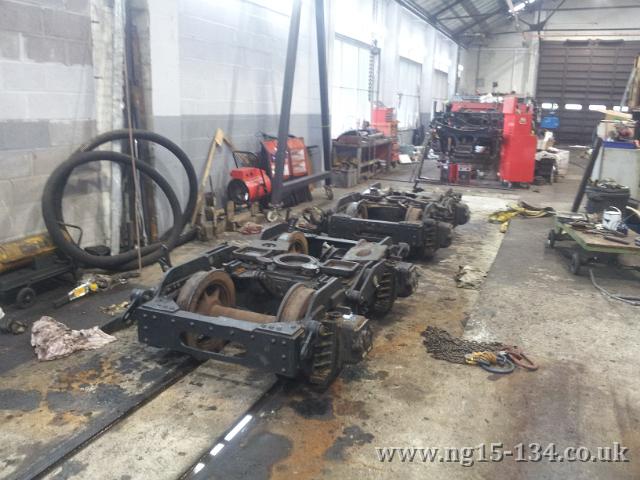 |
The tender bogies now returned from Boston Lodge.
Note: there are not many pictures in the Galley at present however, more are hoped to be added soon.
With regards to the tender, the body (that has been mentioned before is currently sat on NG15 №133's tender chassis) was having the steps moved at the last working party. Only one of the two rear access steps had been fitted so far, however this was fitted slightly, and rather annoyingly slightly at that, to the centreline of the body. This would have prevented the fitting of a Stone's Tonum headlight on the tender rear should the opportunity occur in the future. This was started at the April weekend and was successfully completed this time round.
The tender body with the rear steps re-fitted.
Finally to mention is that the full time staff have been continuing with the refurbishment of the mechanical lubricator.
April 2014 Working Party
This April working party was preceded by two of the team working on the loco for a few days during the week prior to the working party weekend. This was done to make progress on the alignment of the driving wheel horns. The inside faces of the horns were all machined to the correct alignment and spacing between the frames. This work continued into the weekend and was followed by starting the alignment and flatness of the faces to axle box.
Also during those days preceding the weekend a number items were re-attached to the frames and this including the reverser. This had been trial fitted in earlier months, however it was removed when work started on the cab supports. At the same time as the volunteer team members were working during the week on the afore mentioned items one of the permanent staff, by way of the railways apprentice at Dinas, was working on refurbishing the mechanical lubricator to be used on the loco.
One of the completed horn guides (left) and the mechanical lubricator (right).
During the working party itself and once everyone else had arrived progress continued on the many areas of activity started on previous working parties. The cab support and running plate edge were one of those where our 'team welder' was kept busy for much of the time, apart from when he was called away to do some welding elsewhere.
Other such activities included the suspension and brake rigging. Most of the components had been trial fitted and pins marked up as to where they fit during an earlier working party. However some items were then removed to receive their final coat of paint. With many of these now fully painted, including some painted on the Saturday morning, re-fitting of the brake rigging components was started, hopefully for the final time now. For the suspension, some components that had been recently fitted were attached using overlong bolts. These were therefore taken out, shortened and refitted. This work also involved the manufacture and fitting of some spacers on one unit to ensure the correct alignment and free running of the main suspension pin that takes the weight from the axle box to the leaf spring.
One advantage of the fitting of these items is that it removes the plethora of components we have lying around and generally just getting in the way of other activities.
One team member, who is also the driving force behind Team Wylfa who work on the loco when they can on weekday evenings, has been steadily progressing the vacuum brake pipe run. Sunday saw the fitting of another length, a quite complex fabrication running past the smokebox saddle.
The vacuum pipe meandering its way around the smokebox saddle
The two members who'd been removing the South African style coupling casting from the front drag box at the last working party finally achieved their aim on the Saturday. This will be replaced with a standard Ffestiniog Railway type as used on most of the recent coaches.
With that job completed on the Sunday morning the two members transferred one of our tool boxes, well our Project Engineer's toolbox really, from our old home in the clip shed to a more convenient position next to the frames! They then spent the afternoon starting work on moving the steps on the rear of the new tender. At this stage only one step had been fitted, however it and the unfitted step would have been positioned slightly too close together such that it would have prevented us being able to fit the large Stone's Tonum headlights.
The removed front coupling casting (left) and working on the tender tank (right).
The last activity to mention regards the frame and axle alignment jigs. These were each fitted with three pins to aid their accurate refitting after removal.
So that was it, another productive working party over, some very visible and satisfying progress, and some perhaps not so satisfying and not so visible, but nevertheless progress all the same.
March 2014 Working Party
Once again this working party ended up being one of satisfying progress being made with much assembly and construction achieved. As is the usual practice this was done by several groups working on a number of separate projects.
The first to mention was the continued progress on the cab and footplate mounting. Our resident 'team welder' continued by welding the lower angle bracket that will form the bottom of the running plate, footplate and cab. By the end of Sunday this was showing the satisfying outline to those features. All these additions continue to make the loco look more like, well a loco, and an NG15 at that.
Associated with this was the attachment of the footplate extension cantilever brackets to the rear of the frames. again all adding to that great feeling of progress.
The completed running plate/cabside support (left) and footplate support brackets (right).
In the meanwhile another two group members were fitting the grease lubrication network to the right hand side of the loco. The left had been done some time ago so this was another outstanding job that was finally completed.
To counter this we do still encounter the odd bit of component removal or dismantling. On this occasion it was the removal, or at least the start of the removal of the front coupling assembly. As built the NG15s had plane unsprung front couplings as in service the locos spent most of their time traveling chimney first. In our case they will be spending equal time running tender first therefore pulling the train by the front draw bar. In view of this it's been decided that we're better off replacing the front draw bar wit a sprung version. there will also be a slight re adjustment of it's position from the rails to be more in line for the WHR stock.
As alluded to earlier, this job was one that was started but not completed. the coupling unit is held on by 12 countersunk head bolts and all these need drilling out from the front of the unit as it is almost impossible to remove them from the inside. Quite how we refit them is a problem for nearer the time! The drilling is slow progress however we'll hopefully have the unit off at the next working party.
Removing bolts fixing the front coupling unit.
Another job covered over the weekend was the repositioning of the attachment bolt hole in the tapered horn blocks. It looks like these were replaced in South Africa and the hole that takes the attaching bolt was in the incorrect position to enable full adjustment of the bearing to be achieved. This involved taping the existing hole and fitting with a stud followed by the filling in of the ends with weld. We then ground the weld back level and drilled the new hole in the position as shown in the drawings. These were left for the full time staff to mill the countersink for the bolt head.
The re-positioned hole in the adjustable horn blocks (right).
Another job completed on the Sunday was the removal of old bearing bushes from the smaller motion components. Also worthy of note is that Team Wylfa have been progressing the painting of various components during their weekly evening working parties. One worthy of note is the painting of the side control spring housings that we dismantled on the last working weekend. And the last job to mention, and also one being progressed by Team Wylfa during the week, is the continued work on fitting the vacuum pipe at the front buffer beam.
February 2014 Working Party
The second working party of the year continued with the same theme of more being put back together than dismantling taking place. Much was achieved during the weekend with groups or individuals working on a number of different tasks on the loco or it's components.
First to mention is the continuation of the removal of the old rod end bearing bushes in preparation for the rods' conversion back to oil lubrication. As always the last was was the difficult one, however, all these are now complete. The rods will be sent away for refurbishment.
Welding work continued on the brackets to be used to attach the new cab and footplate. The pre-bent lower angle pieces were clamped in place and the previously attached brackets adjusted to ensure correct fitting and alignment. Also taking place at the rear of the loco was the continuation of the fitting of the draw bar anchoring castings into the dragbox. These are needing a bit of tweaking to get them to fit and with them being heavy items it's becoming a very awkward and time consuming job.
One of the last bits of dismantling to be done was associated with the refurbishment of the pony truck side compensation spring units that were started last month. We had to abandon the task last time as we needed two lengths of screwed rod with which we could slowly release the tension of the springs within the two units. We found one length and made the other so we were able to remove the springs and check condition of them. It also enabled us to inspect the inside of the units together with their other components. One unit did have a bit of wear from where the spring had been pressing against the inside, however, we believe that with careful assembly we should be able to prevent this from happening again so we'll leave it as it is. Neither of the springs matched the drawings, although these had a note to say the drawing had been updated. Unfortunately we did not have the up to date drawing to hand to check. The decision has since been made to replace both springs and have made to the revised drawing.
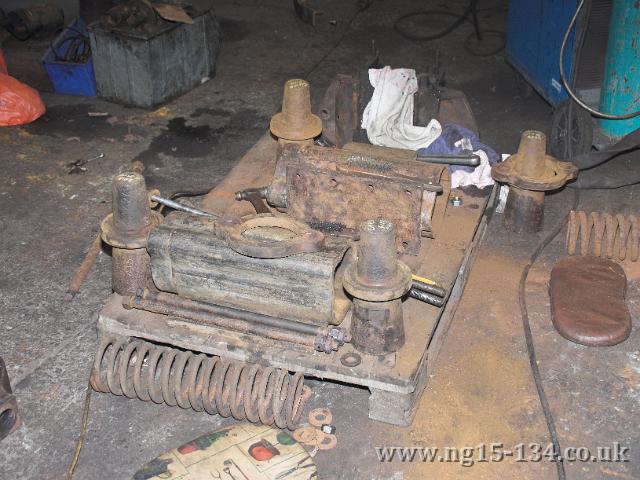 |
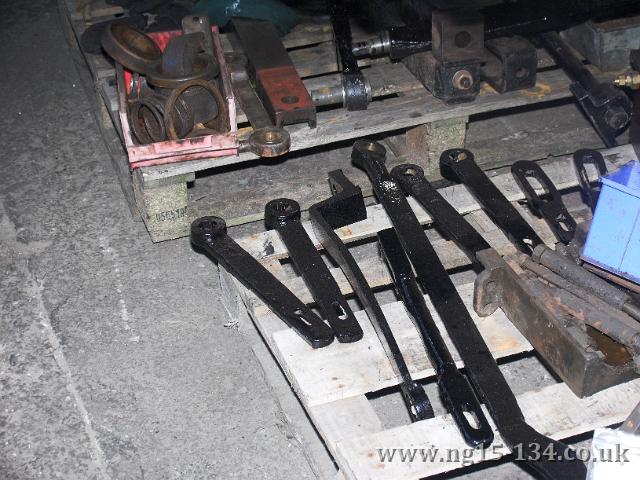 |
The dismantled pony truck side compensation units (left) and painted brake and suspension components (right).
The vacuum reservoir chambers that had been stripped last month were cleaned and painted in undercoat. Also associated with the vacuum braking system, on the Sunday work continued with the manufacture and assembly of the vacuum pipe that will run through the loco. It's been started at the front end and will continue to be routed through to the rear. Once the pipe was tacked in place at the front it was amazing how much more of a loco it looked.
And finally there was the painting. Once we'd satisfied ourselves on the last two working parties that all the brake and suspension rigging were in place and fitted correctly, it was time to paint them. Team Wylfa have been doing this on their weekly evening working parties although there were still one or two left that were therefore painted on the Saturday.
All told, another satisfying weekend with more components being fitted and painted.
January 2014 Working Party
A new year begins in the restoration of NG15 №134, a year that should contain much visible progress.This being the case with this first working party of the year, as whilst there was still a small amount of cleaning and dismantling still taking place, by far the larger proportion of activity this weekend was associated with painting and re-assembly.
On the dismantling and refurbishment side there were three focuses of attention. One was the continued refurbishment of the motion and this time it was the turn of the connecting rods to have their bushes removed. This is so as we can convert the motion back to the 'as built' oil lubrication from the hard grease as it was converted to in South Africa.
Next to mention was the refurbishment of the point truck side compensation spring units. This consists of a coil spring held in compression in an assembly, there being one for each truck. We need to inspect these then paint the units ready for re-assembly into the loco. The outsides were duly scraped off of rust and scale then wire brushed clean. Each unit is held together with two long bolts and so these were loosened, although not removed. We could really have done with two large threaded rods to insert in their place to help decompress the springs, however as none could be found we'll need to acquire some and complete the job next time.
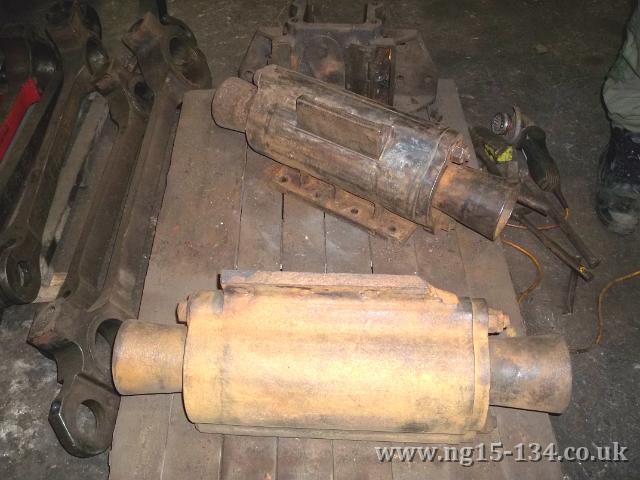 |
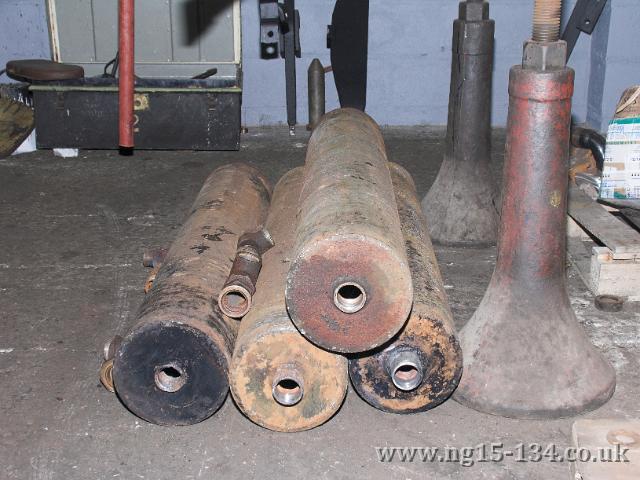 |
Pony truck side compensation units (left) and the vacuum reservoirs following removal of old fittings (right).
Finally on the dismantling side was the removal of the old fittings from the vacuum reservoirs recently acquired as surplus to requirements at Boston Lodge. In some cases the fittings were easy to remove after the application of some heat to get the threads to part company, however as is always the case, the last cylinder of the four took longer than the previous three put together. This ended up with us having to carefully cut the old pipe out of the cylinder. It's a strange phenomena this dismantling game - there's always one awkward one and invariably it's always the last one you do!
Next onto the painting, and there was plenty of that taking place. It included completing the base and undercoats of the rear section of the frames where the rear frame stretcher and rear drag box had been re-fitted, as well as those two items themselves. All this is now ready for top coat, although there are still one or two minor bits associated with the cab and footplate that need adding. The later patching of the paintwork there with be a quick minor job afterwards.
Also painted up to just needing the top gloss coat were most of the brake rigging and and suspension components. These are now being kept in their place on the frames and simply taken down for painting then reinstated afterwards. Various other bits that were in need were also tidied up in the areas of the frame that are painted red.
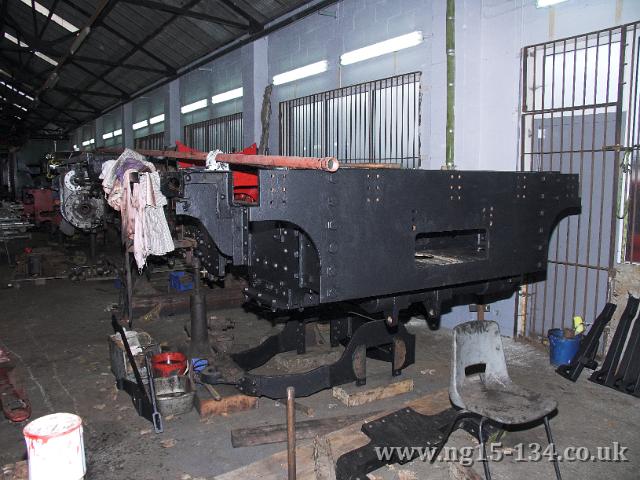 |
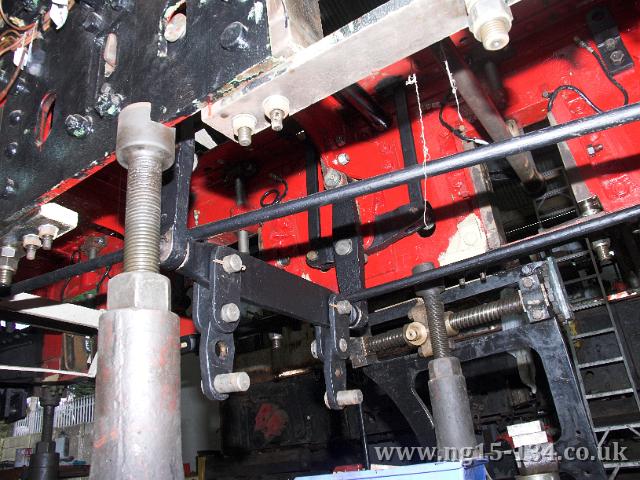 |
The result of the weekend's painting, the rear of the frames (left) and the brake and suspension components (right).
What else? Oh yes,.. as mentioned, we assembled some bits as well, or at least started to. We'd removed the drag box coupling castings from rear drag box whilst it was being painted on the inside. It was always a very tight fit and so we has to grind some faces for it to be a better fit, and especially now everything is painted. As it still needs to be an accurate fit it involved the castings being removed, ground followed by a trial re-fitting, in turn followed by removal and grinding again, well several times actually!
We also started assembling the slide bars (again) to check their final fit. The left hand side had both bars fitted although we still need to grind the two spacing shims by a few thou to ensure the bars are the correct spacing over their whole length. The right hand side had it's piano wire reinstated, as we'd broken this last time, then the top slide bar fully aligned to this. although the lower slide-bar still needs fitting and checking, A job to be carried over to next time.
And finally we come to the last activity to mention and that was that one of the guys manufactured a jig to be able to mass produce vacuum pipe mounting clips. He was just able to complete it and test it by making the first clip late on Sunday afternoon.
As as can be detected, we made good progress an many fronts, with us leaving with a good sense of achievement and of the loco coming back together nicely.
2008, 2009, 2010, 2011, 2012 & 2013 reports are now in the Archive